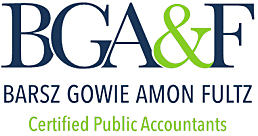A lot has been written in the press about the U.S. Tax Cuts and Jobs Act of 2017. Our experts at Barsz Gowie Amon & Fultz took the time to study the comprehensive legislation, and provide the following list of tax changes and implications so you will be better prepared at tax time.
Changes for S Corporations, LLC’s, Partnerships, Sole Proprietorships and Nonprofits
- New Deduction for S corporations, Partnerships, Sole proprietors, Limited Liability Companies (LLCs).
- Limitations on losses from businesses—up to $250,000 for individuals and $500,000 for married filing jointly.
- Limitations on using net operating losses (NOLs) against income.
- No longer able to carry net operating losses back to prior years; you can only carry them forward.
- Partnerships will no longer terminate if a partner who owns 50% or more of the company leaves the company.
- S corporation that converts to C corporation: Some dividends are taxable on a pro rata basis.
- Changes in calculations of unrelated business income (UBI) for nonprofit organizations.
- The deduction of business interest expense is limited to 30% of the business’ adjusted taxable income. An exemption applies if the average annual gross receipts for the prior three-year period do not exceed $25 million.
- The Domestic Production Activities Deduction is repealed.
- Deductions for entertainment expenses are disallowed.
- The cash method of accounting may be used by taxpayers if their average gross receipts for the prior three-year period do not exceed $25 million.
- Taxpayers that meet the $25 million gross receipts test are not required to account for inventories.
C Corporation Changes
- Corporate tax rate is reduced to a flat 21% rate.
- Corporate Alternative Minimum Tax is repealed.
Depreciation Rule Changes
- The maximum amount expensed under Code Section 179 is increased to $1 million and the phase-out threshold is increased to $2.5 million.
- Cost recovery of qualifying business assets is increased as follows:
- 100% for property placed in service after September 27, 2017, and before January 1, 2023.
- 80% for property placed in service after December 31, 2022, and before January 1, 2024.
- 60% for property placed in service after December 31, 2023, and before January 1, 2025.
- 40% for property placed in service after December 31, 2024, and before January 1, 2026.
- 20% for property placed in service after December 31, 2015, and before January 1, 2027.
- Luxury automobile depreciation limits increased to $10,000 for the year vehicle placed in service; $16,000 for the second year; $9,600 for the third year; and $5,760 for the fourth and later years.
- Qualified improvement property placed in service after December 31, 2017, is generally depreciated over 15 years using the straight-line method.
Contact us if you need help understanding any of these changes, or to create a strategy for your business’ tax and accounting needs.




